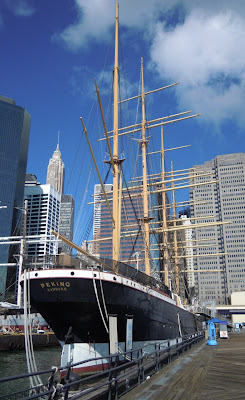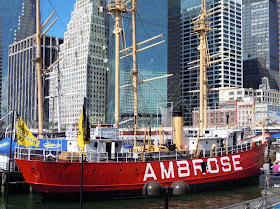The South Street Seaport is on the East River side of Manhattan in and around Pier 17. The area has been designated an historic district and features some of the oldest restored early 19th-century commercial buildings in New York. The Seaport forms part of America's National Maritime Museum, and was designated as such by Congress in 1998.
Amongst the renovated and restored vessels on display at the Seaport are:
The Wavertree was built in Southampton, England, in 1885 for R.W. Leyland & Company, who were based in Liverpool (Wavertree is a district in Liverpool). She was one of the last large sailing ships built of wrought iron and was originally used to transport jute between India and Scotland.
Within two years of being launched Wavertree was switched to carrying general cargo and she remained a sailing 'tramp' until 1910, when she was dis-masted off Cape Horn. As a result she was sold to new owners who used her as a floating warehouse at Punta Arenas, Chile. In 1947 she was converted to become a sand barge, and she remained as such until she was bought in 1968 by the South Street Seaport Museum and restored.
Peking
Peking was built in 1911 by Blohm & Voss, Hamburg, for F Laeisz. The owners intended her to be used to carry nitrates from Chile to Europe. The ship was interned during World War I and handed over to Italy as reparations ... but she was then re-sold to her original owners who kept her in service until 1932.
She was then sold to become a children's home and training school and was moored at Greenhithe (on the River Thames) and later Chatham (on the River Medway). During her service in this role she was named Arethusa II, although during World War II she was requisitioned by the Royal Navy to serve as an accommodation ship and was re-named HMS Peking. After the war she resumed her role as a children's home and training school, and in 1975 she was sold and became part of the South Street Seaport Museum's collection of historic ships.
The wooden-hulled W O Decker began life as the Russell I. She was built at Long Island City in 1930 for the Newtown Creek Towing Company, and was renamed W O Decker when she was sold in 1946 to the Staten Island-based Decker Towing Company. In 1968 she was sold to Dock Incorporated of Stratford, Connecticut, and was renamed the Susan Dayton.
She was originally powered by a steam engine, but was re-engined with a diesel engine later during her service. The Susan Dayton was donated to the South Street Seaport Museum in 1986 when she was retired from regular towing duties and renamed W O Decker.
The Ambrose (LV87) was built 1908 and served as such until 1932. She then served at a number of other locations (with appropriate new names) until she was retired by the US Coast Guard in 1964. In 1968 she was given to the South Street Seaport Museum, and in 1989 she was declared a National Historic Landmark.
Whilst we were visiting South Street Seaport a New York Police Department river patrol boat came alongside the pier, and two of the patrol officers came ashore ...
... to buy donuts ... just like they are supposed to do in the films and on TV!
I would not have believed it if I had not seen it with my own eyes.
Amongst the renovated and restored vessels on display at the Seaport are:
- Wavertree (1885): a fully rigged cargo ship
- Peking (1911): a four-masted barque
- W O Decker (1930): a tug
- Ambrose (1908): a lightship
The Wavertree was built in Southampton, England, in 1885 for R.W. Leyland & Company, who were based in Liverpool (Wavertree is a district in Liverpool). She was one of the last large sailing ships built of wrought iron and was originally used to transport jute between India and Scotland.
Within two years of being launched Wavertree was switched to carrying general cargo and she remained a sailing 'tramp' until 1910, when she was dis-masted off Cape Horn. As a result she was sold to new owners who used her as a floating warehouse at Punta Arenas, Chile. In 1947 she was converted to become a sand barge, and she remained as such until she was bought in 1968 by the South Street Seaport Museum and restored.
Peking
Peking was built in 1911 by Blohm & Voss, Hamburg, for F Laeisz. The owners intended her to be used to carry nitrates from Chile to Europe. The ship was interned during World War I and handed over to Italy as reparations ... but she was then re-sold to her original owners who kept her in service until 1932.
She was then sold to become a children's home and training school and was moored at Greenhithe (on the River Thames) and later Chatham (on the River Medway). During her service in this role she was named Arethusa II, although during World War II she was requisitioned by the Royal Navy to serve as an accommodation ship and was re-named HMS Peking. After the war she resumed her role as a children's home and training school, and in 1975 she was sold and became part of the South Street Seaport Museum's collection of historic ships.
- Displacement: 3,100 tons
- Length: 320 feet
- Beam: 45 feet 7 inches
- Draft: 16 feet
- Sail Area: 44,132 square feet
The wooden-hulled W O Decker began life as the Russell I. She was built at Long Island City in 1930 for the Newtown Creek Towing Company, and was renamed W O Decker when she was sold in 1946 to the Staten Island-based Decker Towing Company. In 1968 she was sold to Dock Incorporated of Stratford, Connecticut, and was renamed the Susan Dayton.
She was originally powered by a steam engine, but was re-engined with a diesel engine later during her service. The Susan Dayton was donated to the South Street Seaport Museum in 1986 when she was retired from regular towing duties and renamed W O Decker.
- Tonnage: 27 tons
- Length: 52 feet
- Beam: 15 feet
- Draft: 6 feet
The Ambrose (LV87) was built 1908 and served as such until 1932. She then served at a number of other locations (with appropriate new names) until she was retired by the US Coast Guard in 1964. In 1968 she was given to the South Street Seaport Museum, and in 1989 she was declared a National Historic Landmark.
Whilst we were visiting South Street Seaport a New York Police Department river patrol boat came alongside the pier, and two of the patrol officers came ashore ...
... to buy donuts ... just like they are supposed to do in the films and on TV!
I would not have believed it if I had not seen it with my own eyes.












No comments:
Post a Comment
Thank you for leaving a comment. Please note that any comments that are spam or contain phishing messages or that come from Google Accounts that are 'Unknown' will be deleted.